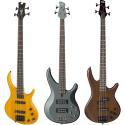Bass String Gauges: Tips From Our Experienced Bass Teacher

Changing bass string gauges can significantly impact the sound and feel of a bass guitar.
String gauges affect string tension, which in turn makes the bass easier or harder to play.
Thicker and thinner strings can also result in different textures and tonal characteristics.
Here I will discuss how different string thicknesses contribute to playability and tone.
I'll answer all the important questions surrounding bass string gauges including:
-
What Is a Bass String Gauge?
-
Why Are There Different Bass Guitar String Gauges?
-
Different Bass String Gauges (Roundwound)
-
How Is A Bass Guitar Tuned?
-
Choosing The Right Material For Bass Guitar Strings
Armed with this knowledge, you'll be able to choose the string gauge that suits your instrument and your playing style. Let's start by answering the most basic question.
What Is a Bass String Gauge?
String gauge refers to a stringed instrument's thickness. This applies to a standard 4-string bass as well as other stringed instruments.
Bass string gauges are measured in fractions of an inch, for example, 0.045. Others also refer to bass strings based on their thinnest string. For example, a set of 0.045-0.100 will be called 45's, in reference to the thinnest string in that set.
The strings of a bass guitar are thicker than those of a standard 6-string guitar.
This is to provide for a lower and thicker sound. As you know, bass guitars occupy the lower end of the sound spectrum.
Why Are There Different Bass Guitar String Gauges?
Different string gauges provide bassists with playability options. For example, beginners will appreciate the slack feel of light gauge sets. Even experienced bassists who have a lighter touch will gravitate towards the flexibility of lighter gauge strings.
On the other hand, if you're an aggressive player, you would want a tighter string tension that can handle hard plucks and pick attacks.
String gauges also provide tonal variety. With thicker strings, you'll get a louder and warmer sound. In contrast, lighter gauge strings will give you a lower output and brighter sound.
Although there's no set rule on this, there are certain string gauges that fit the genre of music you're playing or want to emulate.
For example, thinner strings will fit more in pop, funk, or jazz, while medium strings will fit more in rock, blues, or country. Heavy strings are also known to be used for metal, hard rock, and progressive music.
Different Bass String Gauges (4-string Roundwound Strings)
Choosing electric bass strings should be based on your personal choice. It's about what feels good in your hands and produces the tone you want.
With that said, here are some common string gauges that you might encounter and the characteristics of each one of them.
Light Gauge - G: 0.045", D: 0.065", A: 0.080", and E: 0.100".
-
Playability: This string gauge enables you to play fast bass lines. Because of its lesser string tension, you can execute techniques such as bending, popping, and slapping more easily. In addition to that, these strings don't cause much fatigue to your hands.
Due to their lighter feel, these strings are often recommended for beginners. Even if you're a long-time player or a pro, this string gauge is great for its light feel.
-
Tone: Light gauge strings emphasize the higher frequencies. This produces a crisp and clear tone.
-
Application: They are frequently used in music styles such as pop, funk, and jazz.
Medium Gauge - G: 0.050", D: 0.070", A: 0.085", and E: 0.105".
-
Playability: Medium-gauge strings strike a balance between playability and tension. They offer a comfortable feel for a wide range of playing styles. It's suited for your techniques, including fingerstyle, slapping, and picking.
-
Tone: The tone produced by medium-gauge strings is balanced. It offers a mix of warm lows and defined highs.
They are also good for chording and have a bright, crisp sound. Plus, they're louder and have more sustain than a light string gauge.
-
Application: Rock, blues, and country bassists frequently opt for medium-gauge bass strings.
Heavy Gauge - G: 0.055", D: 0.075", A: 0.090", and E: 0.110".
-
Playability: Heavy-gauge strings have higher tension, resulting in a stiffer feel. While this may require more finger strength, it provides stability and control. So, if you're a player who prefers a solid, anchored feel, these strings are for you.
With its heavier bass strings, it can handle hard hitting bassists, and won't be prone to string buzz and other issues resulting from heavy playing style. Note that heavy gauge strings can cause some necks to warp, so it is best to consult with the bass manufacturer before switching.
-
Tone: They deliver a powerful and deep tone with a rich low-end. They are known for sustaining notes longer and producing a rich, resonant sound.
-
Application: These strings excel in genres like metal, hard rock, and progressive rock.
A Short Note on Other String Wounds
Flatwound Strings: Flatwound bass strings will have more friction on your hands than roundwounds. This is due to its flat and wide surface area. These strings are known for producing a warm and mellow tone with a pronounced low-end, good for Jazz, Motown, or blues.
Half-Round Strings: Half-round strings combine elements of both roundwound and flatwound strings. This balances the smoothness of roundwounds and the punchiness of flatwounds. The tone of half-round strings has a good mix of warmth and clarity.
Tapewound: These strings have a smooth, tape-like winding that provides a comfortable and soft feel under your fingers. These strings are warm and mellow, making them suitable for vintage sound applications.
How Is A Bass Guitar Tuned?
A standard bass string set contains four strings. It's tuned E-A-D-G. This is similar to the tuning of the four lower strings of a standard guitar, but an octave lower.
A 5-string bass can either be tuned B-E-A-D-G or E-A-D-G-C. Meanwhile, a 6-string bass is tuned B-E-A-D-G-C. For an even deeper tone, you can drop-tune your bass.
As you drop-tune your bass guitar, you also reduce its string tension, making it flabby. To compensate for this loss, you should choose heavier gauge strings, or higher gauge strings.
Another important factor when choosing strings is string length, this will be based on the scale length of the instrument. Brands like Ernie Ball, D'Addario, Dunlop, Elixir Strings, and more, offer bass strings in different scale lengths.
Choosing The Right Material For Bass Guitar Strings
String gauge isn't the only thing that affects the feel and tone of your bass guitar. Quite a lot goes into it (including gear, scale length, etc.). One of these elements is the material the bass string is made from.
-
Stainless Steel Strings: These strings are known for their bright tone, which has a bit of a low end. They emphasize high frequencies, providing a crisp and clear sound.
They retain their tonal clarity and don't sound very muddy, even in drop tuning. stainless steel strings have good sustain but produce lower output. They also introduce more friction to your fingers than nickel-plated strings.
Stainless steel is resistant to corrosion and has high tensile strength. This means these strings are durable and long-lasting. If you have acidic sweat or play in humid environments, these types of strings are a great option for you.
-
Nickel-plated steel Strings: They strike a balance between warmth and brightness. These strings offer a versatile tonal profile with a mix of rich lows and defined highs.
Its nickel plating provides a smooth surface, contributing to a comfortable playing experience. Nickel-plated steel strings still offer decent protection against rust.
Nickel-plated steel strings are a popular and widely used choice among bassists.
-
Pure Nickel Strings: A warmer and more mellow tone with a pronounced low midrange (ballsy tone) compared to nickel-plated strings. Pure nickel strings are also favored for their vintage or classic tones.
They often have a more natural and slightly textured feel compared to nickel-plated or stainless steel strings.
-
Cobalt Strings: With a mix of cobalt and iron, cobalt strings are more magnetic than steel and nickel. This results in a higher magnetic response, which increases output and produces a powerful, dynamic tone.
They provide a clear and well-defined sound, making these strings suitable if you want high-gain and a punchy sound.
-
Coated Bass Strings: Coated strings are more resistant to corrosion and have an extended lifespan. These strings can sound like a new set of strings for a longer period of time compared to uncoated strings.
Conclusion
Different bass string gauges give you options to modify your overall bass playing experience. You can change string gauges better serve your playability and tone needs.
In general, thicker bass strings have a stiffer feel and a louder, darker sound. On the other hand, lighter strings have less tension but are quieter and have a brighter sound.
For students, I recommend light gauge strings, as they are more forgiving to fingers that haven't developed callouses.
If you are an experienced bassist, then use the information provided here to narrow down your choices to a specific gauge range.
Your bass guitar is in charge of holding down a steady pulse for a song, along with the drums. So comfort and good tone are important for providing a consistent and reliable rhythm section.
If you have more questions about bass strings or bass guitars, check out the FAQ section below or this article on how to tune a bass guitar.
Frequently Asked Questions
Can I Mix and Match Bass String Gauges In A Set?
Yes, many bassists customize their bass string sets by mixing gauges to achieve the desired feel and tone. For example, they use lighter strings for the two higher strings and heavier ones for the two lower strings.
Do different string gauges require adjustments to the bass setup?
Yes, changing string gauges can affect the bass's setup. A different string gauge will cause a different strain level on your guitar.
That is why adjustments to the truss rod, bridge, and others are necessary. This is done to maintain proper playability and intonation.
You have to check with your bass manufacturer when switching to heavy gauge sets because too much tension can damage to your instrument.
How often should electric bass strings be replaced?
It depends on factors like your playing style, environmental conditions, and personal preference. As a general rule, bassists change strings every few months to maintain tone and playability.
Bass guitar strings are pricey, so it pays to extend your bass string's life span by maintaining them. Simple steps like washing your hands before and after using your bass. Also, wipe the strings and frets after each session.
Are there specific string gauges for drop-tuning or alternate tunings?
Medium to Heavy gauges are often preferred for styles that require drop-tuning. Installing a heavy set prevents excessive floppiness on your bass. Some players choose specific gauges for alternate tunings based on their tension preferences.
Contributors:
- Jerome Arcon - Co-writer
- Jerry Borillo - Illustrator












